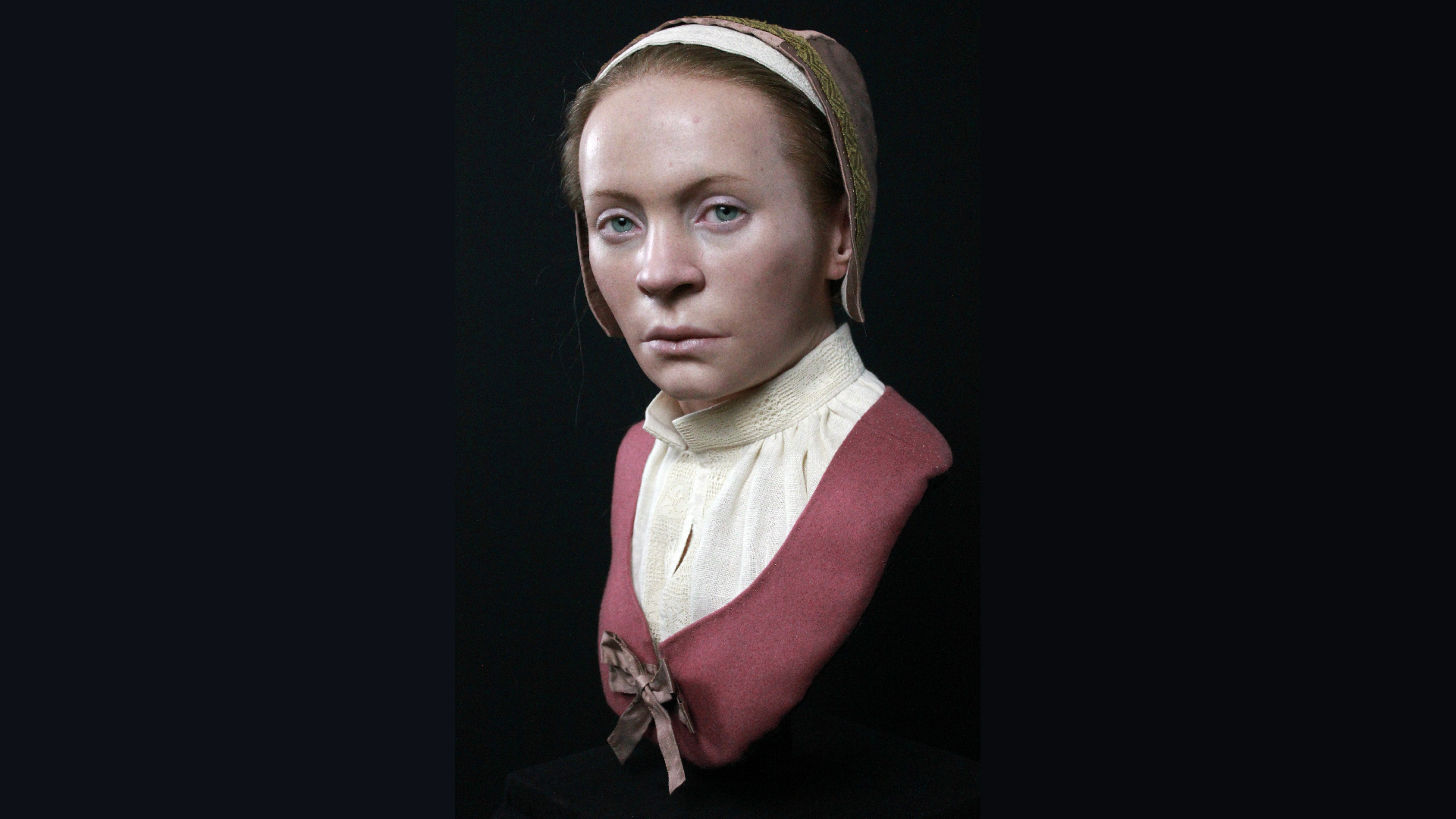
Centuries ago, villagers buried a "vampire" — a young-but-sickly woman — under a lock and blade. Now, a new reconstruction of this individual, who possibly came from a wealthy family, reveals what she may have looked like.
Although buried in Poland, the woman likely grew up in Scandinavia, a chemical analysis of her remains found. A skeletal examination showed that she had several debilitating health conditions, including a painful cancer in her sternum.
When archaeologists found the woman's burial in a cemetery in Pień, a small village, in 2022, they quickly realized that the 17th-century villagers who buried her were fearful her dead body would reanimate and terrorize them.
"She was found with the once sharp blade of a sickle placed over her neck, and a padlock around her left big toe," Oscar Nilsson, a Sweden-based forensic artist who sculpted the woman's likeness, told Live Science in an email.
This unusual burial was intended "to prevent her from coming back after death and haunt the living," Nilsson said. According to Polish folklore, dangerous people possess a good and a bad soul. If the good soul leaves, the bad could take over the body, "and a vicious creature could arise: a 'striga'" — a demon akin to a vampire, Nilsson explained.
Related: 45 amazing facial reconstructions, from Stone Age shamans to King Tut
The villagers likely hoped that the padlock would keep the woman's "good soul" in her body. However, archaeologists noticed that the padlock had been opened, Nilsson said.
Roughly one-third of the 100 burials in the cemetery were those of "deviants," or individuals who receive different and often disparaging burial treatments. Across archaeological sites in Europe, people given deviant burials include suspected criminals, unbaptized infants, people with disabilities and supposed revenants, according to the book "Deviant Burial in the Archaeological Record" (Oxbow Books, 2008). In the case of the Polish cemetery, items such as stones and padlocks had been placed in those burials, with the intention of preventing the dead from rising, Nilsson said.

Despite her maligned burial, it appears that the woman came from a wealthy family. Archaeologists found fragments of a silk bonnet and "the remains of a gold brocade ribbon," Nilsson said. "This glittering textile was a very exclusive item that only could have belonged to an individual of a wealthy family, maybe a nobility family."
The ribbon style dates to the 17th century, textile expert Maria Cybulska found, according to Nilsson. So the woman may have lived during the Thirty Years' War, a series of religious, territorial and political conflicts that took place between 1618 and 1648. For the reconstruction, Anna Silwerulv, a research assistant at the Vasa Museum in Stockholm, "designed and [masterfully] tailored the clothes that we decided should reflect her wealthy high status and origin," Nilsson added.
Fainting spells and malnutrition
The woman was 18 to 20 years old when she died and around 5 feet, 4 inches (162 centimeters) tall, a skeletal analysis found. A DNA analysis was unable to determine her skin, eye and hair color, but it did point to a heritage from southern Scandinavia, possibly Sweden, as did an analysis of isotopes, or variants of elements, found in her remains, Nilsson said. Isotopes are absorbed into the body through drinking water and diet.
Based on these analyses, Nilsson gave the reconstruction blue eyes, dark blonde hair and pale skin. Other skeletal features suggested she had debilitating conditions. For instance, her sternum revealed evidence of a nonlethal but painful cancer; signs on her neck vertebrae indicated Kimmerle's anomaly — a condition that can cause severe headaches, sudden attacks of fainting and even stroke; and Harris lines, which some but not all research suggests can indicate malnutrition or trauma during childhood, were found on her shin bones.

"All this together, she was the odd one out in her community," Nilsson said. "This might have caused the villagers of Pien to fear her, or sooner blame her for things that went wrong. And after her death they clearly were terrified of the possibility that she would arise and come back as a vampire."
To reconstruct the woman's likeness, Nilsson took a plastic copy of her skull and calculated her tissue depth based on a dataset of young women from Northern Europe. Factoring in her undernourishment, he then reconstructed the muscles on her face and calculated the size and shape of her nose, mouth and eyes. He used pigmented silicone for her skin and real human hair to complete the project.
While it's impossible to recreate this woman's life, she may have felt alienated by the way people feared and avoided her, Nilsson said, so he modeled her as if on guard, looking over her shoulder.
"I do feel sad for her, she needed medical help but instead of this she was treated as something dangerous and vicious," he said. "I felt a need to restore not only her face, but also her human dignity. She must be shown as the young girl she was, and not as the monster she was buried as."







